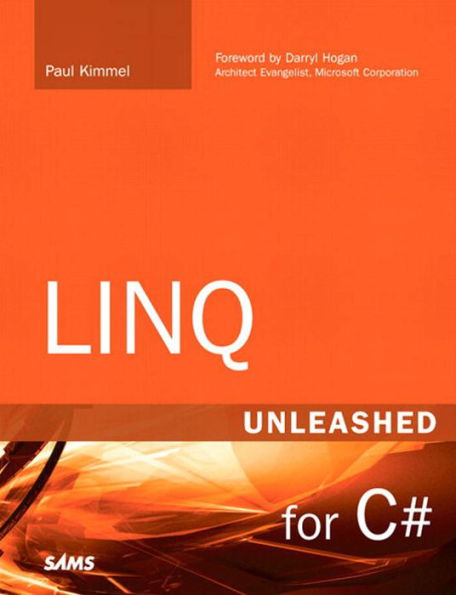Microsoft’s highly anticipated LINQ query technology makes it easy to retrieve any information programmatically from any data source, no matter where it comes from or how it’s stored. Using LINQ, developers can query objects, relational databases, XML documents, and ADO.NET datasets--and do it all directly from C# 3.0, leveraging the powerful capabilities of LINQ.
This is a definitive guide to getting real-world results with LINQ, using C# 3.0 and Visual Studio 2008. In LINQ Unleashed, Microsoft MVP Paul Kimmel covers every facet of LINQ programming, showing how LINQ can help you dramatically improve your productivity and build more reliable, maintainable applications.
Kimmel begins by reviewing the state-of-the-art C# programming techniques LINQ uses, including anonymous types, partial methods, and Lambda expressions. Next, using realistic examples and easy-to-adapt sample code, he details the most powerful new LINQ techniques for accessing objects, databases, and XML. You’ll gain a deep and practical understanding of how LINQ works “under the hood”--and learn how to do everything from selecting data through integrating XML with other data models.
- Build efficient LINQ queries to .NET objects, SQL databases, and XML content
- Utilize anonymous types to reduce design time, coding effort, and debugging time
- Automatically generate .NET state machines with the new yield return construct
- Master LINQ query syntax, operators, extension methods, sorting, grouping, aggregate and set operations, and more
- Make the most of select--and use it in the business layer of your n-tier applications
- Query relational data stored in Microsoft SQL Server
- Use nullable types to eliminate unnecessary database access plumbing code
- Use LINQ with ADO.NET 3.0 and Microsoft’s powerful new Entity Framework
- Extract XML data without the hassles or complexity of XPath
- Automatically construct XML from CSV files and other non-XML data
- Query Active Directory by extending LINQ
Microsoft’s highly anticipated LINQ query technology makes it easy to retrieve any information programmatically from any data source, no matter where it comes from or how it’s stored. Using LINQ, developers can query objects, relational databases, XML documents, and ADO.NET datasets--and do it all directly from C# 3.0, leveraging the powerful capabilities of LINQ.
This is a definitive guide to getting real-world results with LINQ, using C# 3.0 and Visual Studio 2008. In LINQ Unleashed, Microsoft MVP Paul Kimmel covers every facet of LINQ programming, showing how LINQ can help you dramatically improve your productivity and build more reliable, maintainable applications.
Kimmel begins by reviewing the state-of-the-art C# programming techniques LINQ uses, including anonymous types, partial methods, and Lambda expressions. Next, using realistic examples and easy-to-adapt sample code, he details the most powerful new LINQ techniques for accessing objects, databases, and XML. You’ll gain a deep and practical understanding of how LINQ works “under the hood”--and learn how to do everything from selecting data through integrating XML with other data models.
- Build efficient LINQ queries to .NET objects, SQL databases, and XML content
- Utilize anonymous types to reduce design time, coding effort, and debugging time
- Automatically generate .NET state machines with the new yield return construct
- Master LINQ query syntax, operators, extension methods, sorting, grouping, aggregate and set operations, and more
- Make the most of select--and use it in the business layer of your n-tier applications
- Query relational data stored in Microsoft SQL Server
- Use nullable types to eliminate unnecessary database access plumbing code
- Use LINQ with ADO.NET 3.0 and Microsoft’s powerful new Entity Framework
- Extract XML data without the hassles or complexity of XPath
- Automatically construct XML from CSV files and other non-XML data
- Query Active Directory by extending LINQ

LINQ Unleashed: for C#
552
LINQ Unleashed: for C#
552
Product Details
| ISBN-13: | 9780768685374 |
|---|---|
| Publisher: | Pearson Education |
| Publication date: | 08/19/2008 |
| Series: | Unleashed |
| Sold by: | Barnes & Noble |
| Format: | eBook |
| Pages: | 552 |
| File size: | 4 MB |
